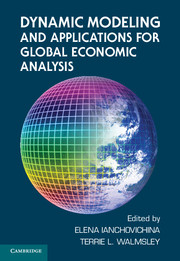Book contents
- Frontmatter
- Contents
- Contributors
- Acknowledgments
- PART I INTRODUCTION AND OVERVIEW
- PART II STRUCTURE OF THE DYNAMIC GTAP FRAMEWORK
- PART III APPLICATIONS OF DYNAMIC GTAP
- 8 Assessing the Impact of China's WTO Accession on Investment
- 9 Dynamic Effects of the “New-Age” Free Trade Agreement between Japan and Singapore
- 10 Resource Use and Technological Progress in Agriculture
- 11 Global Economic Integration and Land-Use Change
- 12 The Contribution of Productivity Linkages to the General Equilibrium Analysis of Free Trade Agreements
- 13 Global Demographic Change, Labor Force Growth, and Economic Performance
- PART IV EVALUATION OF THE DYNAMIC GTAP FRAMEWORK
- Appendix: Negative Investment: Incorporating a Complementarity into the Dynamic GTAP Model
- Glossary of GDyn Notation
- Index
- References
10 - Resource Use and Technological Progress in Agriculture
Published online by Cambridge University Press: 05 June 2012
- Frontmatter
- Contents
- Contributors
- Acknowledgments
- PART I INTRODUCTION AND OVERVIEW
- PART II STRUCTURE OF THE DYNAMIC GTAP FRAMEWORK
- PART III APPLICATIONS OF DYNAMIC GTAP
- 8 Assessing the Impact of China's WTO Accession on Investment
- 9 Dynamic Effects of the “New-Age” Free Trade Agreement between Japan and Singapore
- 10 Resource Use and Technological Progress in Agriculture
- 11 Global Economic Integration and Land-Use Change
- 12 The Contribution of Productivity Linkages to the General Equilibrium Analysis of Free Trade Agreements
- 13 Global Demographic Change, Labor Force Growth, and Economic Performance
- PART IV EVALUATION OF THE DYNAMIC GTAP FRAMEWORK
- Appendix: Negative Investment: Incorporating a Complementarity into the Dynamic GTAP Model
- Glossary of GDyn Notation
- Index
- References
Summary
Introduction
The world's rate of population growth is slowing, but total population is still increasing at about 80 million per year and is expected to reach 10 billion by the middle of the 21st century (World Bank 1999). Most of this growth will take place in developing countries, particularly in Asia and Africa. These projected increases in population, along with growth in per capita incomes and associated changes in demand for agricultural commodities, are expected to increase pressures on natural resources both through the expansion of land under cultivation and through more intense use of resources already employed in agricultural production. In support of these expectations, a recent study by Evenson et al. (1999) estimates that without the development of high-yielding varieties of crops, prices for developing country consumers would likely be much higher than they are today. For example, technological advances in the cultivation of rice have reduced costly food imports by 8% and have eliminated the need to convert millions of hectares of forestland to agricultural uses, as would have been required had yields remained at 1960 levels. This evidence and the rise of food and resource prices in 2008 highlight the central role of agricultural research in ensuring sustainable rural development and food security in high-growth developing countries and in reducing the strain on forest ecosystems.
Information
- Type
- Chapter
- Information
- Dynamic Modeling and Applications for Global Economic Analysis , pp. 269 - 289Publisher: Cambridge University PressPrint publication year: 2012
